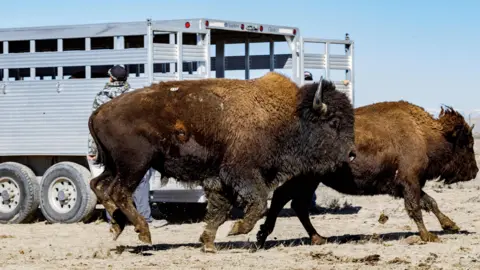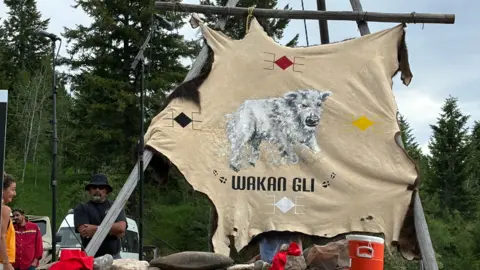By Max Matza, BBC News, Seattle
With cream-colored fur and jet-black eyes, one of the smallest specimens of America’s largest native animal stumbled into the spotlight on shaky legs.
Advocates hope the June birth of a white buffalo calf – an exceedingly rare event – will translate into new momentum for a decades-long push to revive the species in America’s Great Plains.
Many tribes consider a white bison birth to be a sacred omen that signifies change. The herd this calf was born into has also become an important cultural symbol – it’s the last wild buffalo herd in North America.
The herd is entering a new chapter of its life as stewardship of the species is increasingly being overseen by indigenous communities again and advocates push to grow bison populations.
The American buffalo, also known as bison, once numbered in the tens of millions before being brought to the brink of extinction in the 1800s. Now, the only wild herd in the US is limited to just 5,000 animals.
But tribes and bison advocates see opportunity as Yellowstone, America’s first national park and the home of the white calf, considers a proposal to expand the wild herd’s size for the first time in decades.
The white calf has added spiritual significance to buffalo advocates’ efforts as they test a long-standing status quo where government policies prioritise beef ranching over the beliefs of native tribes.
A prophecy revealed
Just after noon on 4 June, Yellowstone photography guide Jordan Creech was sightseeing with clients when he spotted the freshly-born white buffalo calf, taking its first steps in the park’s Lamar Valley.
Bison calves can walk within two minutes of being born, and run alongside their herd within the first seven minutes of life.
“It’s the most unique experience I’ve ever had,” Creech says.
Erin Braaten, a photographer of Native American descent from Kalispell, Montana, also witnessed the calf’s first moments of life before it disappeared into the herd.
“I thought I’d have a better chance of capturing Bigfoot than a white bison calf,” she tells BBC News.
For the last 2,000 years the people of the Lakota, Dakota and Nakoda tribes have told the story of a woman who arrived during a time of need.
A version speaks of two scouts searching for food and buffalo in the Black Hills of South Dakota.
The mysterious woman appeared and offered their tribe a bundle of sacred gifts, including a pipe carved from red rock, and instructed the people on how to live and pray.
She transformed several times before taking the form a white buffalo calf with a black nose, black eyes and black hooves. As she departed, a great number of buffalo returned to feed the people.
Dozens of other tribes have white buffalo stories, interpreting its arrival as both a blessing and a warning.
 Buffalo Field Campaign
Buffalo Field CampaignChief Arvol Looking Horse, a spiritual leader of the Lakota Tribe, is known as the Keeper of the Sacred Bundle — the bundle and pipe left by the spirit. He likens the white calf’s return to the second coming of Christ.
Looking Horse, 70, said that before she departed, the woman told the people that she would return as a white buffalo calf “when everything is sickly and not good, and when people are with a not good mind”.
“This is spirit. It means spirit is happening,” he added.
On 26 June, more than 500 supporters formally celebrated the white calf at an event in West Yellowstone, just outside the park. Nearly a dozen tribes were represented.
Together, they heard the name bestowed upon the calf – Wakan Gli, meaning Sacred Returns or Comes Holy in the Lakota language. An altar of three buffalo skulls and three buffalo robes marked the occasion.
Waemaetekosew Waupekenay, 38, who travelled from Wisconsin to attend on behalf of the Menominee Tribe, said the birth of the sacred calf has been a spiritual awakening.
Its arrival, he says with amazement, shows that “there’s a lot of healing, a lot of love going around. People are being united.”
 Buffalo Field Campaign
Buffalo Field CampaignNational Park rangers at Yellowstone have confirmed the white bison’s birth, but rangers have not reported any sightings themselves.
“The birth of a white bison calf in the wild is a landmark event in the ecocultural recovery of bison by the National Park Service,” the park said in a statement on 28 June confirming it as the first white bison ever seen inside Yellowstone.
They added that it “may reflect the presence of a natural genetic legacy that was preserved in Yellowstone’s bison, which has revealed itself because of the successful recovery of a wild bison population”.
“The National Park Services acknowledges the significance of a white bison calf for American Indians,” it added.
A species reborn
The Yellowstone bison make up the only wild herd in the US and are among the last genetically pure bison in existence.
But Yellowstone National Park regularly reaches the legally-permitted capacity of 5,000.
Tribes who support the species’ growth have stepped in, believing the species’ health is tied to their own history. Since 2019, the US National Park Service has transferred 414 healthy bison from Yellowstone to 26 tribes in 12 states through the Bison Conservation Transfer Program.
Native people also have their own distribution system to share buffalo independent of the park’s efforts. Since 1992, the Intertribal Buffalo Council – a collective of 83 tribes working to “restore the cultural, spiritual and historic relationships” with the animals – has sent 25,000 bison to 65 herds on tribal lands in 22 states.
“People don’t understand or realise that what happened to the buffalo similarly happened to native people, and that history is intertwined,” says Jason Baldes, who serves as vice-president of the council and is a member of the Eastern Shoshone Tribe.
The returning of buffalo to tribal people marks a major change in federal policy for a country whose soldiers had once been ordered to kill them all to deprive tribes of food and supplies.
And officials are not only returning animals, they’re considering taking on more themselves: the National Park Service has just completed an environmental impact study at Yellowstone, and determined that the size of the herd should increase from 5,000 to 6,000 – but could accommodate as many as 10,000. It’s the first time the park has proposed an increase in 24 years.
The herd’s growth is made more striking by the fact that up to 60 million American buffalo were killed in the rush to claim ownership of the American frontier.
Unlike the native people – who are known to use nearly every part of the animal for food, shelter and more – the settlers killed them with reckless abandon, taking furs and leaving carcasses to rot.
By the 20th Century, no more than 1,000 bison remained in the wild.
Large-scale cattle operations took over the empty land and commercial interests continue to be a source of conflict between those who wish to see the wild buffalo roam as they once did, and the livestock industry.
 Doug Spriggs/InterTribal Buffalo Council
Doug Spriggs/InterTribal Buffalo CouncilRanchers and the state’s Republican governor oppose the park service’s proposal to expand the herd, fearing a disease called brucellosis – which is carried by about 60% of Yellowstone bison – could infect beef herds and undercut profit margins.
The Montana Stockgrowers Association, which opposes the plan, has warned that the new policy could lead “to an exponential growth in bison numbers”.
Elk are also known to transfer brucellosis to domestic livestock, but do not face the same restrictions as bison.
Mike Mease of the Buffalo Field Campaign, a Montana-based non-profit which works to increase wild bison numbers, says the debate “is part of the old range wars of the West, competition for grass and which animals get to eat it”.
Yellowstone officials previously conceded that the controversy over bison management is a complex challenge with several opposing interest groups.
“It’s probably the single-most challenging wildlife issue in Yellowstone,” Cam Sholly, the park superintendent, told the New York Times last year. “The bison is the only species we constrain to a boundary.”
But for tribes, the birth of the white calf is proof that more needs to done to support bison. The fact that the calf comes from Yellowstone has imparted it with extra spiritual significance.
“The Yellowstone [herd] are the most purest, wildest buffalo – the only left in the country,” Chief Looking Horse says.
“This is a message that Mother Earth is speaking through the animal nation.”
 Buffalo Field Campaign
Buffalo Field Campaign

